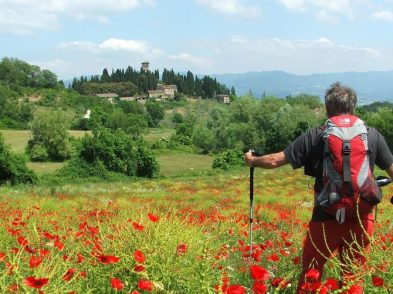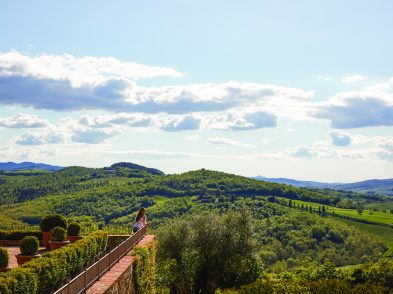No
other television fiction series in Italy has enjoyed such a following
as Il
Commissario Montalbano,
based on the detective novels by Andrea Camillieri. It is no doubt
the most popular television series in the long history of Italy’s
state braodcaster, RAI, reaching 38 percent of shares, or 10 million
viewers, on the last episode of the season, The
Age of Doubt.
Italy’s version of Sir Author Conan Doyle’s Sherlock Holmes and
Agatha Cristie’s Inspector Poirot, Inspector Montalbano’s success is
due to the ever-popular whodunit genre, breathtaking views of Baroque
Sicily and the engaging mix of Montalbano’s taciturn demeanour and
investigative acumen.
Italy’s
most beloved fictional detective, Salvo Montalbano, is based in
Vigata, Sicily. Despite this fictitious name, the fictional home of
one of Italy’s most popular literary characters is closely based on
the southern Sicilian coastal town of Porto Empedocle, the birthplace
of the inspector’s creator and award-winning novelist, Andrea
Camilleri. In recognition of his great success, Vigata has been
appended to Porto Empedocle’s name. A perfect way to discover this
part of Sicily is to use the stories and TV episodes themselves as
your guide.
We began our
exploration in Empedocle. At its heart lies via Roma, a charming and
tree-lined key location familiar to all Camilleri fans. The street is
littered with cafes, but there really is only one choice: Salvo’s
favourite, the Caffè Albanese, now known as Bar Vigata. Stop for a
fresh ricotta-filled cannolo,
sip an espresso and watch passersby, the majority of whom could have
stepped from the pages of any Montalbano novel.
Near the bar, you’ll
find the inspector himself but don’t expect Luca Zingaretti, his TV
incarnation. This inspector couldn’t be more different:
moustachioed, ageing yet with a full head of hair. The inspector we
are looking at is a statue, commissioned to celebrate Porto
Empedocle’s favourite son, who is based on Camilleri’s scant
descriptions of him in the series. Looking a little perplexed,
perhaps chewing over the nuances of a particularly tricky case, we
imagine he’d soon be in his car and heading home.
Montalbano’s home is the
suburb of Marinella, an outer neighbourhood of Emepedocle. Heading
there, going west on the Trapani road, we stopped at the Lido di
Marinella. The expanse of sand is edged with whitewashed villas;
their terraces, bathed in sunlight, border on the beachfront and it
doesn’t take much imagination to see our inspector sipping a glass
of whisky as the sun sets.
The coast to the west of
Marinella leads to the Turkish Steps, a natural marl cliff formation
that declines spectacularly towards the sea. In the height of summer,
bathers and sun worshippers throng the area, but Montalbano fans know
it has a darker side. When Salvo needs to meet secretly with his old
friend and informer, Gegè, the Steps provide much needed privacy,
especially at night. Don’t miss the view from the road above, even
if you don’t stop for a swim.
Not far from Porto
Empedocle is the larger settlement of Agrigento. Camilleri takes some
aspects of this town to create the fictional town of Montelusa. It is
home to Montalbano’s dreaded boss, Bonetti-Alderighi, as well as
the regional police headquarters and the Moorish district of the
Rabatu. The district clings to the hillside and a network of narrow
passageways intersects ramshackle courtyards. The author describes
these veins and arteries as ‘tortuous’ when he takes Salvo there
to track down a potential lead.
Less tortuous is the
Valley of the Temples. However, if you were to ask Salvo’s
girlfriend, the long-suffering Livia, she may have a different
opinion, often being sent there to sight-see whilst Montalbano is
(yet again) urgently called away. The ancient temples sit in an
olive-strewn valley on the outskirts of town and are one of the great
sights of Magna Grecia and a UNESCO World Heritage site. Of more
interest to Montalbano fans are the olive trees themselves. Find one
with a gnarled, biblical trunk and sit in its shade, as the inspector
often does under his favourite Saracen tree.
At this point, we closed
the books and began taking our clues from the TV episodes. Further to
the east, along the southern coast of Sicily, are the locations used
for RAI’s massively popular television series. Many of the street
scenes are filmed in and around Piazza del Duomo, at the heart of
Ragusa Ibla, one of Sicily’s baroque jewels. When Salvo leaves his
desk in search of a long lunch, he passes ornately sculpted
balconies, high-arched doorways and the similarly tiered wedding cake
of the San Giorgio cathedral. His usual destination is the Trattoria
San Calogero, ably played by the real Trattoria La Rusticana in Corso
XXV Aprile. As the name suggests, it specialises in flavoursome,
regional dishes. If you are eating outside under the vine arbour, be
sure to peek inside, where you’ll find the unmistakable patterned
arches that appear in the TV episodes, as well as photographs of the
cast and crew.
To locate the Vigata
police headquarters, head south and make a stop in the stunning
baroque town of Scicli, smaller sister to Ragusa. The entire Val di
Noto area has been designated a UNESCO World Heritage site for its
history and striking beauty. The town hall in via Mormino Penna
doubles as the Commissariato di Vigata.
A sign outside with images of Fazio, Mimi and Salvo reflect the
town’s pride at being part of the television series.
The most iconic image for
all Montalbano aficionados is his beachside house in Marinella.
Palomar, the company behind the television series, chose a property
relatively close to Scicli, which was practically on the beach at
Punta Secca. The journey down to the coast is best made when the
afternoon fades to dusk behind the olive groves and dry stone walls.
The intersecting maze of sturdy, weathered rocks also have their part
to play in the inspector’s cases. You’ll see them in several
episodes, with a victim fleeing her persecutors or the comical
Catarella hunting mushrooms amongst the crevices.
In Punta Secca, head
for the Piazzetta della Torre Scalambri. This square features an
eleventh-century tower, which, although it is no longer the star of
the show, having given way to Salvo’s house at the opposite end of
the little square, it is still a must-see. The wrap-around upper
gallery and shaded lower terrace throw shadows over the sands below.
Montalbano often clears his head by taking a solitary stroll along
this beach or cutting through the surf to the head of the bay. Back
on the balcony, the phone rings, another case begins: ‘Montalbano
sono …’
The Camilleri Fan
Club website has a wealth of information on Inspector Montalbano; see
www.vigata.org.
If you missed the end-of-season escapades of Italy’s best-loved
inspector, you can watch these and others at www.rai.tv. Need a
dictionary to understand the Sicilian-Italian jargon and linguistic
nuances? See http://www.montalbano.tv/dizionario.
Accommodations
When the film crews
are not in town, you can actually stay at Salvo’s house in Punta
Secca: see www.discoveringsicily.com.
Tours
Organised tours retrace
the books or TV espisode locations; click
www.montalbanotour.eu/Montalbano_Sicily_tour.html.
Eating out
Salvo’s new choice after
the Trattoria San Calogero closed (fictionally, of course) is the
Osteria al Timone Da Enzo, on via Nino Bixio in Porto Empedocle (tel.
333/4132461). In real life, the Trattoria San Calogero is La
Rusticana, which serves tasty local foods in Ragusa Ibla (tel.
0932/227981).




